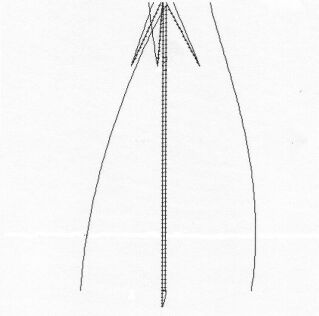
Return to KLUBNL.PL main page

| To: | LF-Group <[email protected]> |
|---|---|
| Subject: | LF: Top loading coil at ground level? |
| From: | Dick Rollema <[email protected]> |
| Date: | Sat, 22 Apr 2006 09:29:51 +0200 |
| Delivered-to: | [email protected] |
| Reply-to: | [email protected] |
| Sender: | [email protected] |
|
The picture I included in the text did not appear in the
message as it reached me. So I try it again. To Jim, Peter, LF-group, I am grateful to Jim and Peter for their interesting comments and discussion which I thoroughly enjoyed. As I mentioned before I first modelled a quarter wave vertical for 80m with the top loading coil system under discussion. As capacitive hat I used the upper 5m of three guy wires, connected to the top of the radiator under an angle of 30 degrees. The bottom end of the stub is 1m above ground level. At the centre of the stub a capacitor. By trial and error I found that 1283pF was needed to bring the system into resonance. At the feedpoint the impedance was 4925 ohm. The current minumum occurs at the feed point and the maximum at the top of the system. The current responsible for the radiation is the vectorial difference of the currents in the two vertical elements. This is shown in the following picture that is produced by the Antenna Optimizer program.  The dots indicate the segmentation I selected: 150 segments/half wave. The curved lines indicate the magnitude of the currents. At the bottom end the currents in the "stub" are almost equal but in opposite direction. The small difference current is flowing in the lower 1m of the radiator between feedpoint and bottom end of the stub. The situation is different of course for the small antennas used at LF. But the principle is the same. I consider as main advantage of the system that the top coil is at ground level and easily accessible. There are no size and weight restrictions as for an elevated coil. The coil can be made as large and good as you like. 73, Dick, PA0SE |
| <Prev in Thread] | Current Thread | [Next in Thread> |
|---|---|---|
| ||
| Previous by Date: | Re: LF: 18.5 kHz in CT, Jay Rusgrove |
|---|---|
| Next by Date: | LF: 18.5 kHz in CT, Jay Rusgrove |
| Previous by Thread: | LF: Top loading coil at ground level?, Dick Rollema |
| Next by Thread: | Re : LF: Top load coil at ground level?, Brenda Hayes |
| Indexes: | [Date] [Thread] [Top] [All Lists] |